The Waco Metropolitan Planning Organization’s 2023 Carbon Reduction Program call for proposals is now open via MPO’s online application system. Proposals will be accepted until 5 p.m. Monday, May 1.
CRP was established by the federal government’s 2021 bipartisan Infrastructure Investment and Jobs Act. The goal is to reduce transportation emissions nationwide, according to a MPO release. At least $550,000 is expected to be allocated within the Waco MPO planning area annually over the next five years.
“CRP funds present an opportunity for the implementation of low-cost, high-impact projects which reduce transportation emissions while benefiting communities,” MPO Director Makesh Kumar said in the release. “Applicants are encouraged to think both strategically and holistically while considering those projects which reduce transportation emissions while also increasing quality of life. “
Submitted proposal overviews will be presented by applicants at the MPO Technical Advisory Committee meeting 2 p.m. Thursday, May 4. Selected project proposals will be announced 2 p.m. Thursday, June 1, during the MPO TAC meeting. Both TAC meetings will be held at the Waco Transit Administration Building, 301 S. 8th St., in Waco. These meetings will be open to the public and the meeting room will be arranged for physical distancing.
Information regarding CRP and the application form may be found on the MPO website at https://www.waco-texas.com/Departments/Metropolitan-Planning-Organization/Forms#section-4.
The Waco Metropolitan Planning Organization is accepting comments on annual performance targets proposed for the Waco Metropolitan Area regarding:
1) roadway safety,
2) public transportation safety, and
3) public transportation asset condition.
Transportation Performance Management is federally required by Congress through the Fixing America’s Surface Transportation Act, according to a release from Mukesh Kumarm WMPO director. “It is a strategic approach that uses goals, measures, and data to make better informed decisions about how to invest transportation funding and improve the performance of the national transportation system.”
The Waco MPO is proposing to support 2023 roadway safety targets established by the Texas Department of Transportation and to support 2023 public transportation safety and asset condition targets established by Waco Transit System, the release said.
MPO is requesting public review and comment on the proposed targets. Information regarding these proposals is available on the Get Involved section of the MPO website: https://www.waco-texas.com/Departments/Metropolitan-Planning-Organization. Comments will be accepted for performance targets through 5 p.m. Feb. 8. Comments should be submitted through the website or directed to the Waco MPO at [email protected] or (254) 750-5650.
The MPO hosted a public informational meeting Tuesday, Jan. 31.
If you were unable to attend the live meeting, a video recording and PDF of the staff presentation are available on the website listed above until the comment periods close.
The Texas Department of Transportation is proposing improvements to Spur 298 (Franklin Avenue) from SH 6 to SL 398 (Valley Mills Drive) in McLennan County and is offering a “virtual open house” now through Thursday, Dec. 8, on the public meeting webpage.
This is not a live event, but the materials can be viewed at your convenience.
Additionally, TxDOT providied an in-person meeting Wednesday, Nov. 16, at SpringHill Suites in Woodway.
TxDOT invites you to learn more and share your comments on the proposed improvements. If you have any questions or need additional information, please contact Michael Rhodes, Environmental Coordinator, Waco District at 254-867-2739 or [email protected].
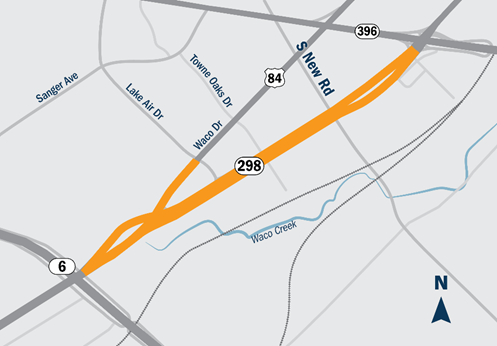

A More Connected Waco
Waco Transit System, the City of Waco, and Waco MPO are Reimagining Waco Transit to better serve your needs. With your help, we can improve connectivity and access for everyone in the community.
The project will involve a comprehensive public engagement process with the goal of fostering respectful and informative dialogue about the community’s mobility needs. Check this site for updates and opportunities to share your thoughts throughout the project.
Learn more about this study and take the survey: Reimagine Waco Transit (arcgis.com)
Continue Spreading the Word!
With all the exceptional responses we collected, we are looking for the chance to receive more before we close the survey on January 1, 2022 for the next phase of engagement. Please continue spreading the word with family, friends, and other interested parities in Waco through your networks, social media, and news outlets. The more people we reach, the more accurate our understanding of Waco transportation!
If you have any ideas for how we can reach more people interested in participating in our survey, please respond to this email with suggestions. We are always open to learning about better outreach and looking to improve our methods. The survey can be accessed through our website or this link: https://forms.gle/wPi4mGWqqWRR8eH86
We appreciate your help and look forward to keeping you updated in the future! Your efforts make this project successful!


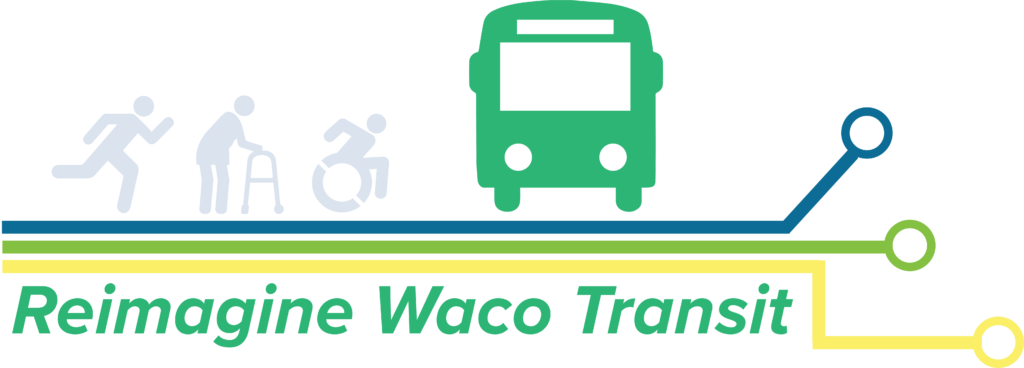
By Allison Smith
Waco Transit System and the Waco Metropolitan Planning Organization are conducting “Reimagine Waco Transit” to improve transit connectivity and mobility for everyone in the Waco community. We want to have a conversation with the community about transit, develop a shared understanding of how best to improve transit for Waco, and gather input on the current system to better inform transit improvements!
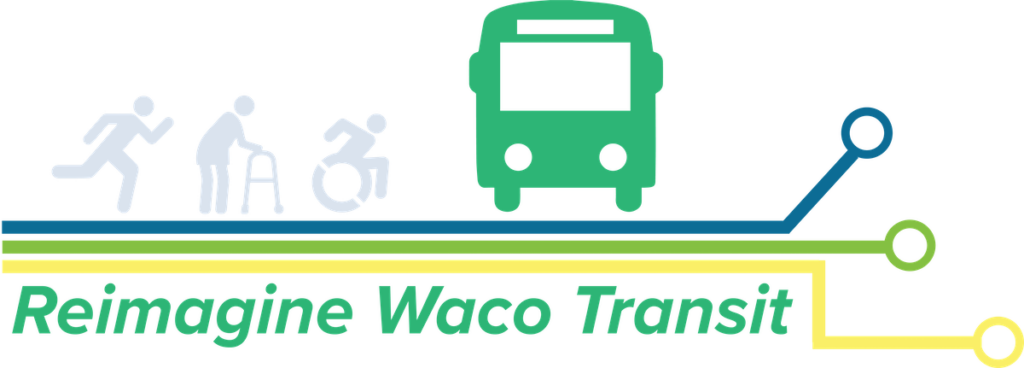
Everyone in is invited to participate in a community survey, whether or not they now ride Waco buses.
We need all the feedback we can get to ensure Reimagine Waco Transit reflects your community values.
For updates and more information about Reimagine Waco Transit, visit our webpage.
The Reimagine process seeks to improve connectivity, minimize travel time, and produce cost-effective transit solutions. The study will produce transit service scenarios that reflect community input, technical analysis, and build off previous efforts. Our robust engagement process aims to both educate about what makes transit work and gather input about what transit should look like in Waco.
Whether you take the bus, ride a bike, use a mobility device, or drive a car, we need your input to help develop transit recommendations for Waco. Understanding the needs and wants from Waco residents will help develop a shared understanding of the benefits associated with quality transit, and your input will help form the transit recommendations.
Your insights will directly shape the future of transit in Waco.
Allison Smith is a planner with Alliance Transportation Group, which is working on the local project.
The Act Locally Waco blog publishes posts with a connection to these aspirations for Waco. If you are interested in writing for the Act Locally Waco Blog, please email Ferrell Foster.
By Serena M. Stevenson
Waco Transit System (WTS) is set to complete the preliminary engineering and environmental review process for the proposed 13-mile Bus Rapid Transit (BRT) project. Completing this process advances the development of Waco’s first BRT project to provide safe, reliable, and efficient transit service.
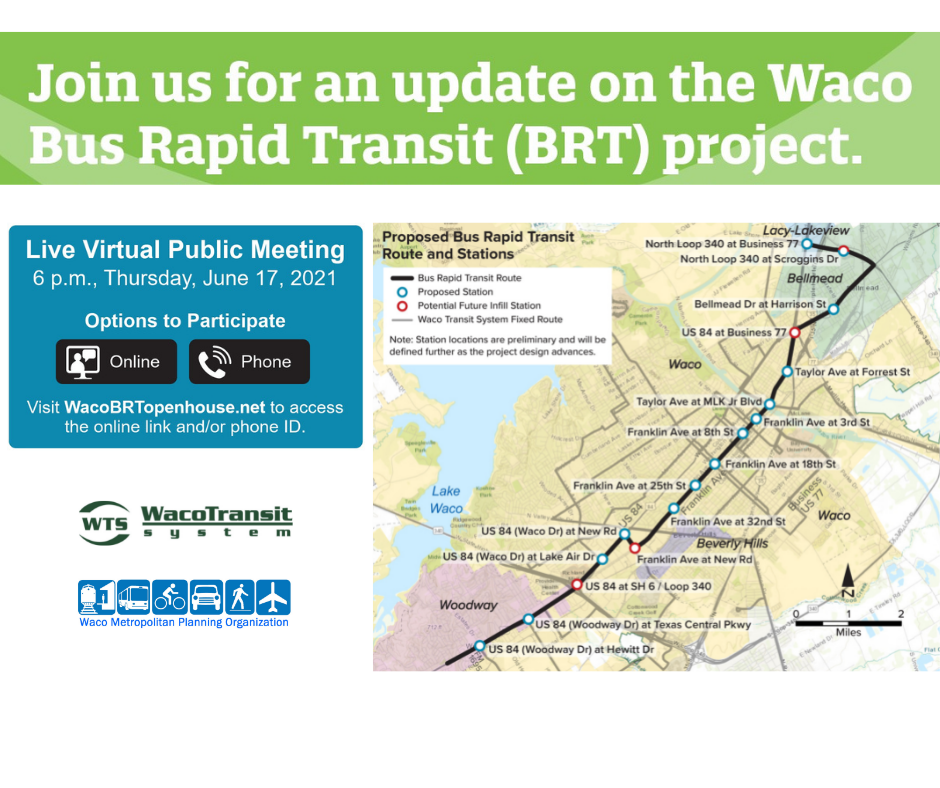
Over the last 10 months, WTS and its consultant have been refining the BRT station design and conducting evaluations to confirm the location for 14 proposed BRT stations. As part of this process, WTS continues to seek public input to help inform the project.
Community members are invited to participate in a live virtual public meeting that will be held at 6 p.m. Thursday, June 17, to learn about the BRT project and share feedback. During this meeting the project team will present the final recommendations for the station locations, provide an update on the station design, and share details about next steps.
In light of restrictions on public gatherings, this public meeting is being offered online and via phone, rather than in-person. Visit WacoBRTopenhouse.net to access the online link and/or phone ID.
The information that will be presented during this live virtual meeting and a recording of the meeting will be made available online at WacoBRTopenhouse.net.
Community members interested in providing feedback to help inform the BRT project are encouraged to call the project comment line at 844-922-6278; email the project at [email protected]; and/or complete the online feedback form available at wacobrtopenhouse.net/feedback. The public comment period for this phase of this project will close Friday, July 2.
About the Waco BRT Project: The proposed 13-mile BRT project that is in development would provide buses every 15-minutes during peak service hours, including extended service hours to 10 p.m. and service on Sundays to offer safe, reliable, and efficient transit service. The purpose for implementing BRT service in Waco is to offer residents enhanced mobility and to provide improved access to jobs, medical and social services, and educational facilities. The proposed BRT route would also provide better and more efficient transfers to other routes operated by Waco Transit System. The BRT project is now at the next phase in the development process which involves preliminary engineering and an environmental review pursuant to the National Environmental Policy Act. For more information about the Waco BRT project, visit the project webpage at waco-texas.com/transit/BRT.
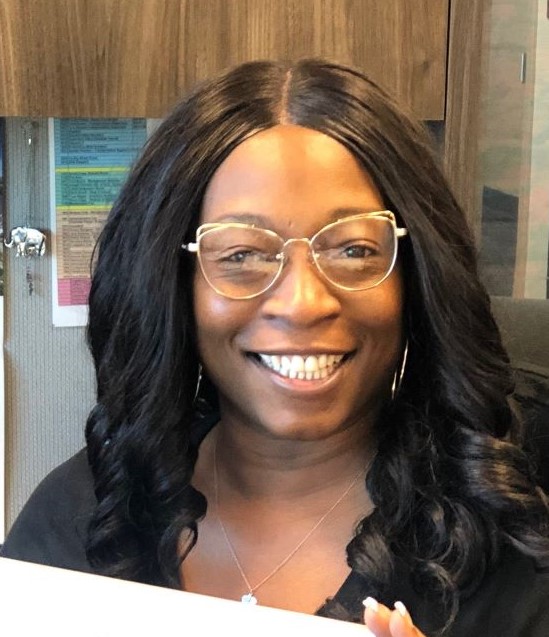
Serena M. Stevenson is general manager of Waco Transit System.
The Act Locally Waco blog publishes posts with a connection to these aspirations for Waco. If you are interested in writing for the Act Locally Waco Blog, please email Ferrell Foster at [email protected].
by Ashley Bean Thornton and others…
The Greater Waco Community only has a certain amount of money allocated for transportation related expenses. Our city planners are asking to hear from us about how we would like to see it spent. They have invited us to give our input at a series of public information meetings. In a blog post last week, I shared some of my thoughts about transportation and specifically tried to make the case for having more emphasis on public transportation as a part of the overall transportation plan for our region.
Here are some other voices sharing their reasons for wanting a more robust system of public transportation in the Waco area:
(In a letter to the Editor of the Waco Trib)
I read with interest Ashley Thornton’s editorial (May 7) on transportation priorities in Waco, finding it compelling and informed.
As a person who works for an agency that helps older adults, I can affirm with Ashley that we have a public transportation system that is not adequate. Up until 2005, Meals & Wheels had a very busy transportation service which focused on the transit needs of older adults in Waco. However, due to funding shifts our transit program for older adults in the city basically dissolved. We were transporting 249 older adults taking 700 trips per month to clinics, hospitals, doctors’ offices, dentist offices, social service agencies, and dialysis centers.
At that time, it was decided by funding sources that the older adults of Waco could utilize the public transportation system or they could qualify for the ADA (physically challenged) vans. Echoing what Ashley reported, this would require older adults who did not qualify for ADA services, to walk to a bus stop, or flag down a bus, ride it to the hub downtown and then change buses to get where they needed to go.
Think about Waco – in a city that doesn’t have many sidewalks, this required people who were using canes or walkers, or who have mobility issues to walk on uneven surfaces or in the streets. Also, very few of the bus stops in Waco are covered, which means the older adults are at stops that have no protection from the weather. Would you want your mother waiting at a bus stop for an hour in 100 degree heat?
Navigating the bus system is also confusing for many of our older adults. We do not have signage that gives the bus routes. To Waco Transit’s credit, they did send out staff to train our former clients, who requested help, on how to use the bus system. However, I imagine these requests were few in number.
So what did they do without the curb-to-curb service? Many fell back on family and friends to take them where they needed to go. Others, some of whom shouldn’t be driving due to vision issues, drive their own cars. Some of our clients were quite capable of riding the Waco bus and have transitioned to that system. However, we still get calls every week from folks wanted to know if we’re giving rides again; or we receive a call from an adult child saying that their parent needs transit help because they shouldn’t be driving anymore.
I ask that the community lift its voice to say we need a variety of public transit options in Waco and share this need with the Metropolitan Planning District who is/was conducting the meetings on transit needs in Waco. We all have to work together to make Waco a community in which one can age well.
Sincerely, Libby S. Bellinger, Associate Director, Meals & Wheels
(In a response on Facebook to my blog post)
Having a decent, accessible, and reliable public transportation system is so important for any city. Having lived in NYC most of my life, it is something I always took for granted until I moved to Waco. I have many friends who don’t drive; they are lifelong New Yorkers, they have never had cause to learn. There are many reasons we should invest in better public transportation: reducing our city’s carbon footprint, being a more welcoming and accessible city for people with disabilities, attracting employees from large cities where public transportation is the norm, and providing a means of transportation to our neighbors who simply cannot afford a vehicle. There are multiple health reasons why a person may not drive. I have a friend whose sister had no choice but to move to a larger city with public transportation. Her sister has epilepsy, therefore she cannot drive. This person would have been a huge asset to our community. She has multiple graduate degrees, is a community builder, philanthropic, and just a very cool person. One of the interim ministers at a local congregation a few years ago was blind. She simply could not live here. She obviously worked on Sunday, yet was completely dependent on others for a ride, as busses don’t run on Sunday. Most people take health for granted, just as many Wacoans take having a car for granted. What would you do if due to an accident or illnesses you could not drive? Could you get to work? Would you be able to get to the market, medical appointments, place of worship, a friend’s house, anywhere?
— Carmen Saenz
(Another response on Facebook to my blog post)
And now the voice of a really senior citizen. We need affordable ways for seniors to get where they need to go such as to doctors, labs, therapy, grocery are necessary. It would be nice to have some entertainment venues accessible also. It would be nice to have access to library services. Perhaps we don’t contribute to the community from the point of view of many but if we had transportation we maybe could contribute. And, we’d grow older more slowly because of the mental stimulation interaction would provide. And, there is conceivably an undocumented safety issue here. Many seniors continue to drive after it is unsafe because they do not have an alternative.
— Joycie Gifford
If you agree that Waco needs more Public Transportation, please make your voice heard! There are two public input sessions remaining where you can speak directly with the representatives from the Metropolitan Planning Organization (MPO). They are : Monday, May 12, 2014 – 6 p.m. at South Waco Community Center, 2815 Speight and Thursday, May 15, 2014 – 12 Noon at Dr. Mae Jackson Development Center, City of Waco, 401 Franklin Ave.
If you cannot attend either of those meetings, you can submit your written comments directly to the MPO, as long as they are received no later than June 15. Suggestions may be submitted by fax at (254) 750-1605, by e-mail to [email protected] or by mail directed to Christopher Evilia at the following address: Waco Metropolitan Planning Organization, P.O. Box 2570, Waco, Texas 76702-2570.
Also, please consider writing a letter to the Waco Trib to help build up the community engagement around the issue.
Transportation planning is complicated and will involve trade-offs. There is simply not enough money to do everything that everyone would like to do in regard to transportation. Our city planners are asking for our input. If we do not give it to them, how can we expect them to prioritize the things that are important to us?
For more information about the Transportation Plan or the community input process, please visit the website: www.waco-texas.com/cms-mpo .
 This Act Locally Waco blog post is by Ashley Bean Thornton, the Manager of the www.www.actlocallywaco.org website and the editor of the Friday Update newsletter. The Act Locally Waco blog publishes posts with a connection to these aspirations for Waco. If you are interested in writing for the Act Locally Waco Blog, please email [email protected] for more information.
This Act Locally Waco blog post is by Ashley Bean Thornton, the Manager of the www.www.actlocallywaco.org website and the editor of the Friday Update newsletter. The Act Locally Waco blog publishes posts with a connection to these aspirations for Waco. If you are interested in writing for the Act Locally Waco Blog, please email [email protected] for more information.
My first car was a yellow AMC Pacer complete with an in-dash 8-track player. It was very round and had huge windows. It was like driving around in a big glass egg. Sounds cool right? Coolness (or lack thereof) aside, from the moment I first turned the key in the ignition of that yellow Pacer until this very moment I have never seriously worried about transportation. A few flat tires and other mal-functions notwithstanding, I have always had an operable vehicle and the means to drive it just about anywhere I wanted to go. And, oblivious well-off person that I am, I have always taken that luxury more or less for granted.
According to the Census Bureau’s 2008-2012 American Community Survey 5-year estimates, there are over four thousand households in Waco with no vehicle available. Those of us who have always had cars may have to let the implications of that sink in for a bit before we can even imagine what life without a vehicle would mean on a day to day basis. I have always taken for granted, for example, that I could get to work at any hour that my employer required. If I forgot something I needed, I have always been able to run home at lunch and get it. I have always taken for granted that I could get the milk and ice cream home before it was spoiled. I have never had to think about how heavy my groceries were and whether or not I would be able to carry them all the way home. I have rarely thought twice about being able to drive to the doctor in air-conditioned comfort if I was feeling bad. For households with no vehicles, these “simple” day to day activities require planning and negotiation, and of course the planning and negotiation is made many, many times more complicated if there are kids in the picture.
Our city is designed around the notion that our residents have dependable transportation. For example, many of our children now attend schools in neighborhoods other than their own. Our grocery stores and drug stores are not located in our residential areas. Perhaps even more important, neither are our workplaces. According to a recent report by the Upjohn Institute to Waco City Council, only 4.6% of the people in Waco work in the same census tract where they live. Transportation is not just a matter of convenience. It has consequences for health, education and certainly for employment.
 For people who do not have access to a private vehicle, public transit is a lifeline. In Waco that lifeline is pretty thin. First of all, in Waco the bus only comes around once an hour. It only operates during limited hours: Monday through Friday from 5:00 AM to 7:00 PM; Saturday from 6:00 AM – 8:00 PM; no service on Sundays. Also, our bus system is a “hub and spoke” system with all routes radiating from the Transit Center on Eighth street downtown. That means if you need to change buses to travel across town, it could end up taking you more than an hour to get to where you are going.
For people who do not have access to a private vehicle, public transit is a lifeline. In Waco that lifeline is pretty thin. First of all, in Waco the bus only comes around once an hour. It only operates during limited hours: Monday through Friday from 5:00 AM to 7:00 PM; Saturday from 6:00 AM – 8:00 PM; no service on Sundays. Also, our bus system is a “hub and spoke” system with all routes radiating from the Transit Center on Eighth street downtown. That means if you need to change buses to travel across town, it could end up taking you more than an hour to get to where you are going.
All of this has implications for employment. If you depend on public transportation, you can’t, for example, have a job that requires you to work on Sundays. If you miss your bus you could be an hour or more late to work. In recent years, we have added the evening LINK, a limited “reservation only” service that people can use to go to work or school between 8:30 and 11: 45 PM. That service has helped some for people who want to be able to work shifts that end after 7:00 PM, but additional service with shorter wait times would make the bus a much more viable option for getting back and forth to work.
I attended a meeting the other day hosted by Waco Transit in which the speaker discussed some of these realities. At the end of the presentation one of the questions he asked was: “Do you believe there is community and political support to increase public transit in the Waco community?” I hope so, for many reasons. Even though I may never personally have to depend on a city bus, I would like to be able to use it sometimes. Also, I am better off if my community is better off, and I believe my community is better off with stronger public transportation. Our community is better off if people who cannot yet afford a car have a dependable way to get back and forth to work in a reasonable amount of time. Our community is better off if families of modest means can get by with one vehicle instead of having to spend precious resources on a second car. Also, as Waco grows in population (and it will), a good public transit system will help us keep the traffic and congestion to a level that we can all tolerate. (Beware the traffic of Austin, my friends!) Selfishly, as I get older, I imagine there will come a time when I can no longer drive my own car. I believe our community is better off if our seniors have a bus system they can depend on to maintain some level of independence.
The Greater Waco Community only has a certain amount of money allocated for transportation related expenses. Our city planners are asking to hear from us about how we would like to see it spent. They have invited us to give our input at a series of public information meetings to be held at different locations around town during the next few weeks, see the details below. I hope you will attend and let them know that you would like to see some of that money invested in a more robust public transit system.
Here’s the invitation: The MPO staff would like to invite all interested persons to attend any of the following meetings regarding development of the new 2040 Metropolitan Transportation Plan. Monday, May 5, 2014 – 6 p.m. at Hewitt Community Center, 208 Chama Drive. Thursday, May 8, 2014 – 6 p.m. at Lacy Lakeview Civic Center, 505 Craven. Monday, May 12, 2014 – 6 p.m. at South Waco Community Center, 2815 Speight. Thursday, May 15, 2014 – 12 Noon at Dr. Mae Jackson Development Center, City of Waco, 401 Franklin Ave. For more information please visit the website: www.waco-texas.com/cms-mpo .
 This Act Locally Waco blog post is by Ashley Bean Thornton, the Manager of the www.www.actlocallywaco.org website and the editor of the Friday Update newsletter. The Act Locally Waco blog publishes posts with a connection to these aspirations for Waco. If you are interested in writing for the Act Locally Waco Blog, please email [email protected] for more information.
This Act Locally Waco blog post is by Ashley Bean Thornton, the Manager of the www.www.actlocallywaco.org website and the editor of the Friday Update newsletter. The Act Locally Waco blog publishes posts with a connection to these aspirations for Waco. If you are interested in writing for the Act Locally Waco Blog, please email [email protected] for more information.
by Felix Landry
The earth has many laws. Some of these laws – like the law of gravity – are well known. Others are less obvious. I’ve noticed a law at work both in nature and in the structure of cities which I call “the law of scale.” There is an important relationship between the size of the creature and the size of the environment it inhabits. They should “scale up” or “scale down” together. If one grows or shrinks without the other, the health of both the creature and the habitat begin to suffer. For example, it is obviously a problem if a mother bird does not make her nest big enough. What may be less obvious is that if the nest is too big that can also cause problems. If a bird builds her nest too large, then the upkeep of the nest eventually consumes the time and energy meant for gathering food and other necessary activities.
This law applies to people as well, but we are not as good at obeying it as the birds seem to be…particularly when it comes to transportation.
 Imagine you work in a busy office building. There are lots of people in the halls all day, but everything generally flows smoothly. Then imagine that for some reason your employer implements the bizarre policy of requiring everyone to wear a refrigerator box whenever you travel the corridors. What would happen? Immediate, aggravating, stressful congestion in the halls. Why? Because your boss has broken the law of scale. You, the creature, got bigger, but the environment did not get bigger. The halls in your office building are built to human scale, not to refrigerator scale. If your boss were determined to continue this refrigerator box policy, the congestion would eventually drive you to take the expensive step of remodeling the building with much wider and longer corridors.
Imagine you work in a busy office building. There are lots of people in the halls all day, but everything generally flows smoothly. Then imagine that for some reason your employer implements the bizarre policy of requiring everyone to wear a refrigerator box whenever you travel the corridors. What would happen? Immediate, aggravating, stressful congestion in the halls. Why? Because your boss has broken the law of scale. You, the creature, got bigger, but the environment did not get bigger. The halls in your office building are built to human scale, not to refrigerator scale. If your boss were determined to continue this refrigerator box policy, the congestion would eventually drive you to take the expensive step of remodeling the building with much wider and longer corridors.
This is very similar to what we do with our current transportation system. When we step out of our homes or offices and into our vehicles, we suddenly explode in size like the incredible hulk. We, the creatures, have scaled up in size, but our environment, the roads, have not scaled up with us. We end up with maddening congestion such as we see along China Spring Hwy or anywhere in the City of Austin. We have broken the law of scale in regard to our city streets, and we will continue to have congestion until we restore the correct proportions.
For 50+ years of vehicle centric development we have tried to deal with this problem by scaling up the environment. We have “hulked out,” we reason, so our roads need to “hulk out” to keep up with us. We have basically fallen into the following pattern:
- More (and bigger) vehicles are on the road,
- Which leads to congested roads,
- Which leads to building wider and longer roads,
- Which in turn increases the distances between destinations,
- Which of course increases our dependence of vehicles,
- Which puts more vehicles than ever on the road.
The above cycle has two major problems in my opinion.
Problem 1: Between steps 2 and 3 whichever government agency wants to build the road must first gather the taxes to pay for the project. We are running out of tax money for road construction and maintenance, and not many people want to raise taxes.
Problem 2: Step 4 boils down to sprawl, which over the long haul decreases the average value of land serviced by the road system, while simultaneously increasing the amount of roads needed. The need for tax revenue increases while the capacity to generate it decreases.
In other words, our current approach to development is leading us to be like the bird who has made her nest too big. We are getting to the point that we must waste valuable resources just to maintain the nest.
Fortunately, there’s another way to approach the problem. We could figure out ways to not “hulk out” between our front doors and our destinations.
 Let’s return to our crazy refrigerator boxes (vehicles) in the corridors (roads) at the office (city) analogy. The refrigerator boxes make each person take up too much space. The root of the corridor congestion is that the halls were not built for such a high space to person ratio.
Let’s return to our crazy refrigerator boxes (vehicles) in the corridors (roads) at the office (city) analogy. The refrigerator boxes make each person take up too much space. The root of the corridor congestion is that the halls were not built for such a high space to person ratio.
Here are some suggestions on how to lower the space to person ratio and ease congestion:
- Don’t take your box on every trip.
- Use smaller boxes.
- Fit more people in fewer boxes. If two or more people are headed to the same destination, they could all take the same box instead of each taking their own.
- Create a system of large high capacity community boxes that travel the main corridors of the office at regular intervals. Anyone could hop into a community box as it passes by decreasing the overall ratio of box area to person area.
Obviously these suggestions have real world counterparts:
- Walk
- Ride a bike
- Car pool
- Public transit
I am not trying to build a “cars are evil” bonfire. We don’t need to get rid of vehicles. But we could choose to scale ourselves down rather than choosing to scale up our road system. We could lower the amount of space people take up traveling on our roads. We could reduce the high vehicle to person ratio that is currently clogging our public right of ways. This “scaling down” could be much less expensive and more sustainable financially in the long run. The great news is that Waco, from what I’ve seen, has a large number of people who would love to lower their own vehicle to person ratio. Yes, we would have to make some initial investments to build the infrastructure to accommodate them. But, with enough support, Waco has great potential to facilitate a much lower vehicle to person ratio which will be a much more sustainable way to satisfy the “law of scale” in the long run.
 Felix Landry is the senior planner and bicycle and pedestrian coordinator for the City of Waco. He and his wife moved here in 2010 from College Station, Texas. They have two young boys.
Felix Landry is the senior planner and bicycle and pedestrian coordinator for the City of Waco. He and his wife moved here in 2010 from College Station, Texas. They have two young boys.
Are you Interested in getting in on the conversation about transportation in Waco? Plan to attend an upcoming Metropolitan Transportation Plan Community input meeting. Meetings are scheduled for May 5, May 8, May 12 and May 15. For more details please visit the website: http://www.waco-texas.com/cms-mpo/ or the Act Locally Waco May Event Calendar.
by Felix Landry
Since I moved to Waco and began working as a city planner, Waco’s poverty has been the topic of discussion I run into most. I hear it at work, church, in local magazines, the newspaper, the radio, from our city leaders, and even at social events. Most Wacoans I know seem to agree that our level of poverty is a huge concern and detriment to our civic health.
Poverty varies across cultures, climates, and geography; it also exhibits consistent elements that are identifiable the world over. Food and shelter come to mind immediately for most people… transportation? It doesn’t come up as often – but it should.
 The vast majority of urban transportation networks in the US are designed to move as many cars as possible at safe speeds. This approach caters to vehicles more than to people, which has resulted in at least two major problems cities are facing today.
The vast majority of urban transportation networks in the US are designed to move as many cars as possible at safe speeds. This approach caters to vehicles more than to people, which has resulted in at least two major problems cities are facing today.
First, many places in the US have no additional space in their public right of ways (ROW) to increase the number of travel lanes for vehicles. Even if additional space were available for purchase (at incredible cost), the funds available for new road construction decrease every year due to the rising cost of maintaining our existing transportation network.
Second, and closer to home, many people cannot afford to purchase or operate a car. AAA has released an annual report, “Your Driving Costs,” every year since 1950 that analyzes the cost of owning a vehicle in the US. According to the 2013 report, the average annual expense for owning and operating a small sedan (think Chevy Cruze or Ford Focus) in 2013 and driving it 10,000 miles was $5,952. That is the cost to pay for insurance, fuel, maintenance and other operating expenses – purchasing the car is an additional cost. According to the Census, 23% of families (31% of individuals) in Waco live below the poverty line. A family of four living below the poverty line has an annual income of $23,050 or less. In other words, that family, in a vehicle-based transportation system, will be using more than a fourth of their small income just to get to work, take the kids to school, and go to the grocery store.
When people come together as town or city, they create an opportunity to pool resources for common infrastructure (i.e. water and sewer lines) and services (i.e. fire and police protection) at a lower overall cost. We readily agree that every citizen has an equal right to such services, regardless of income. However, our existing transportation network does not always provide the same level of service regardless of income. Most transportation systems in the US cater primarily to the most expensive (and dangerous) form of transportation: personal vehicles.
 Many sections of the transportation network in the US could carry more people if they were re-designed for multiple forms of transportation instead of just for vehicles. The photo on the left illustrates this principle well. It shows the same 60 people along with the number of bikes, cars, or buses it would take to carry them. The drawing on the right illustrates how a network designed to move people rather than vehicles facilitates a higher traffic volume without expanding the right of way. Such a
Many sections of the transportation network in the US could carry more people if they were re-designed for multiple forms of transportation instead of just for vehicles. The photo on the left illustrates this principle well. It shows the same 60 people along with the number of bikes, cars, or buses it would take to carry them. The drawing on the right illustrates how a network designed to move people rather than vehicles facilitates a higher traffic volume without expanding the right of way. Such a 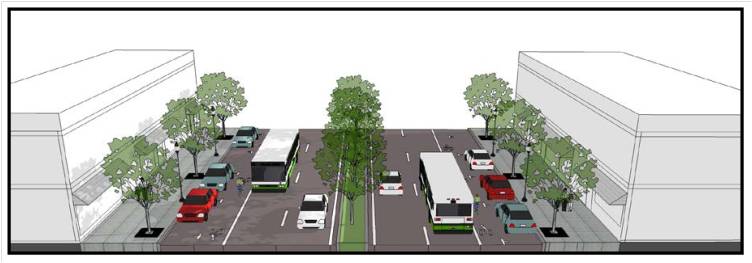 design is more efficient and effective: Dedicated space for pedestrians and cyclists, and shared space for vehicles and buses can move more people than the same amount of space designed strictly for personal vehicles. It also decreases the amount of public funding needed for construction and maintenance and generates a transportation network viable for all income levels.
design is more efficient and effective: Dedicated space for pedestrians and cyclists, and shared space for vehicles and buses can move more people than the same amount of space designed strictly for personal vehicles. It also decreases the amount of public funding needed for construction and maintenance and generates a transportation network viable for all income levels.
Improving and diversifying our transportation network would alleviate some of the burdens that keep people impoverished. Not only would it provide greater economic potential for low income earners, but it would also increase Waco’s appeal to businesses and new residents. It’s no coincidence that attractive places to live in and visit around the world often have a viable public transit system and walkable streets.
 Felix Landry is the senior planner and bicycle and pedestrian coordinator for the City of Waco. He and his wife moved here in 2010 from College Station, Texas. They have two young boys.
Felix Landry is the senior planner and bicycle and pedestrian coordinator for the City of Waco. He and his wife moved here in 2010 from College Station, Texas. They have two young boys.

